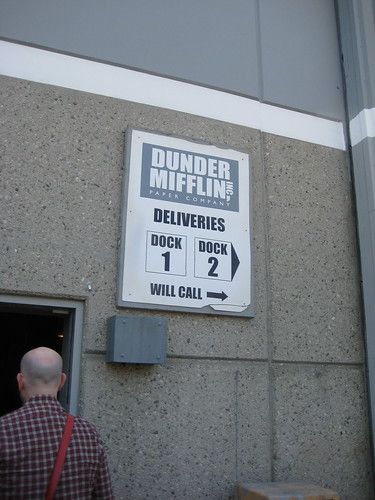Dunder Mifflin
General Info

| City | Scranton |
|---|---|
| Area/Region | Pennsylvania |
| Country | United States |
| Website | www.dundermifflin.com |
| Latitude | [object Object] |
| Longitude | [object Object] |
| Telephone | (570) 555-0000 |
| Postal Code | 18505 |
| Location Name | Dunder Mifflin |
| Alternate Name | Dunder Mifflin Paper Company |
| Street Address | 1725 Slough Avenue |
Overview
Dunder Mifflin has a typical office building exterior, but the interior tells a different story. The staff's imagination is reflected in the workspace, which is decorated with a quirky mix of party decorations, joke accessories and personal memorabilia. From the headquarters to the annex, every square foot of Dunder Mifflin comes alive with fun interactions and absurd scenarios unfolding within its walls.
This Scranton office is run by a well-intentioned but abusive regional manager and his eccentric and hard-working staff, including salespeople, accountants, warehouse workers and receptionists. Despite their mundane job of selling paper, the team manages to make every workday extraordinary and unpredictable, turning Dunder Mifflin into a world of alliances, rivalries and hilarious stories.
At the heart of all this is the unique corporate culture of Dunder Mifflin, which, despite the many differences, brings the characters together. It is more than just a paper company. A place of cherished relationships, humorous misunderstandings and memorable moments, Dunder Mufflin is an enduring symbol of the collective human experience at work.
History
The Scranton branch, which became a television sensation thanks to the documentary "The Office," has seen several significant management changes throughout its history. It was originally led by Ed Truck, who was replaced by the unforgettable Michael Scott. Scott's unique management approach literally and figuratively set the Scranton facility apart.
After the departure of Michael Scott, the branch went through a brief period of uncertainty and several short-term changes before Andy Bernard stepped in and restored stability, despite the occasional hiccups. The company faced several obstacles during its lifetime, including a successful but ultimately disastrous merger attempt with the Stamford branch and a takeover of the Saber printing company.
Despite the complex corporate takeovers and management rollercoaster, Dunder Mifflin has remained more than a workplace for its employees, but more of a family. Dynamic office action, unusual history and inevitable drama helped Dunder Mifflin Scranton cement its place in the annals of television history as the quintessential portrayal of the American workplace.
Over the years, Dunder Mifflin has not only been a major player in the paper supply industry, but has become a conduit for unforgettable memories and relationships for its employees that are still remembered and loved by millions.
Background
Dunder Mifflin's Scranton facility is located in a small office park and blends seamlessly into the overall aesthetic of the industrial landscape. It is strategically located to serve dozens of small and medium-sized businesses in Northeastern Pennsylvania and offers a wide selection of paper and office supplies. Within the walls of this industry, ordinary office events often turn into unexpected adventures. From the Office Olympics, botched fire drills to the Casino Night charity, the Scranton institution is known for its antics and often absurd business ventures. This is largely due to the unconventional management style of Michael Scott, the branch's regional manager for most of the series, whose humorous but good-natured leadership has created an office culture unlike any other.
The employees at this location are not just colleagues. The connections made, the romances born, the rivalries born, and the friendships forged in Scranton have made Dunder Mifflin more than just a place to work. For many who stepped on the carpet, Dunder Mifflin Scranton became a second home.
Through all the changes, setbacks, and the occasional paper sale, Dunder Mifflin Scranton has carved a rich history in its day-to-day operations and become a beloved icon in television history. It's not just a paper company; it is a symbol of the unconventional, unexpected and unforgettable moments that the workplace can offer, highlighted and captured in Office.
